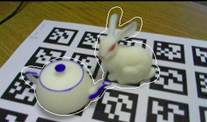Abstract Non-photorealistic rendering (NPR) is an attractive approach for seamlessly blending virtual and physical content in Augmented Reality (AR) applications. Simple NRP techniques, that use information from a single rendered image, have been demonstrated in real-time AR systems. More complex NRP techniques require visual coherence across multiple frames of video, and typical offline algorithms are …
Category: Conferences
Oct 08 2008
BragFish paper got accepted by ACE08
Congratulations~ I will attach the full paper and video later. Abstract: In this paper, we present our research on social interaction in colocated handheld augmented reality (AR) games. These games are characterized by shared physical spaces which promote physical awareness between players and individual gaming devices which support both public and private information. One result …
Mar 08 2008
Uncertainty Boundary for Complex Objects in AR
Abstract Registration errors between the physical world and computer-generated objects are a central problem in Augmented Reality (AR) systems. Some existing AR systems have demonstrated how to dynamically estimate registration errors based on estimates of spatial errors in the system. Using these error estimates, these systems also demonstrated a number of ways of ameliorating the …
Oct 06 2005
AR Karaoke: Acting in Your Favorite Scenes
Maribeth Gandy, Blair MacIntyre, Peter Presti, Steven Dow, Jay David Bolter, Brandon Yarbrough, and Nigel O’Rear. “AR Karaoke: Acting in Your Favorite Scenes” In The Fourth International Symposium on Mixed and Augmented Reality (ISMAR 2005), October 6-8, 2005, Vienna, Austria.
Oct 06 2005
Butterfly effect: an augmented reality puzzle game
Abstract Butterfly effect is a 3D puzzle game using augmented reality. The key motivation was to create a game that leverages the structure of the physical world during gameplay without requiring the computer to have a detailed model of the space. The butterflies are virtual, but the space the player navigates is physical. The player …
Oct 24 2004
DART: A Toolkit for Rapid Design Exploration of Augmented Reality Experiences
Blair MacIntyre, Maribeth Gandy, Steven Dow, and Jay David Bolter. “DART: A Toolkit for Rapid Design Exploration of Augmented Reality Experiences.” In Conference on User Interface Software and Technology (UIST’04), October 24-27, 2004, Sante Fe, New Mexico.
Oct 24 2004
DART: A Toolkit for Rapid Design Exploration of Augmented Reality Experiences
Abstract In this paper, we describe The Designer’s Augmented Reality Toolkit (DART). DART is built on top of Macromedia Director, a widely used multimedia development environment. We summarize the most significant problems faced by designers working with AR in the real world, and discuss how DART addresses them. Most of DART is implemented in an …
Oct 24 2004
DART: A Toolkit for Rapid Design Exploration of Augmented Reality Experiences.
Abstract In this paper, we describe The Designer’s Augmented Reality Toolkit (DART). DART is built on top of Macromedia Director, a widely used multimedia development environment. We summarize the most significant problems faced by designers working with AR in the real world, and discuss how DART addresses them. Most of DART is implemented in an …
Oct 13 2004
Presence and the Aura of Meaningful Places
Abstract We propose the term aura to enrich the current language for designing and analyzing media experiences, especially when using augmented reality, mixed reality and ubiquitous computing technology. Aura describes the cultural and personal significance that a place (or object) holds for an individual. An MR application can exploit aura to make the user’s experience …
Sep 07 2004
Prototyping Applications for the Physical World Using Integrated Capture/Playback Facilities
Abstract Designers of digital applications that deal with complicated infrastructures in the physical world often deal with the formidable challenges of working in a specific place. During development and testing, the designer must constantly move around the physical space to debug or test new interactions. In outdoor settings, factors such as weather, poor work ergonomics, …
- 1
- 2


Recent Comments